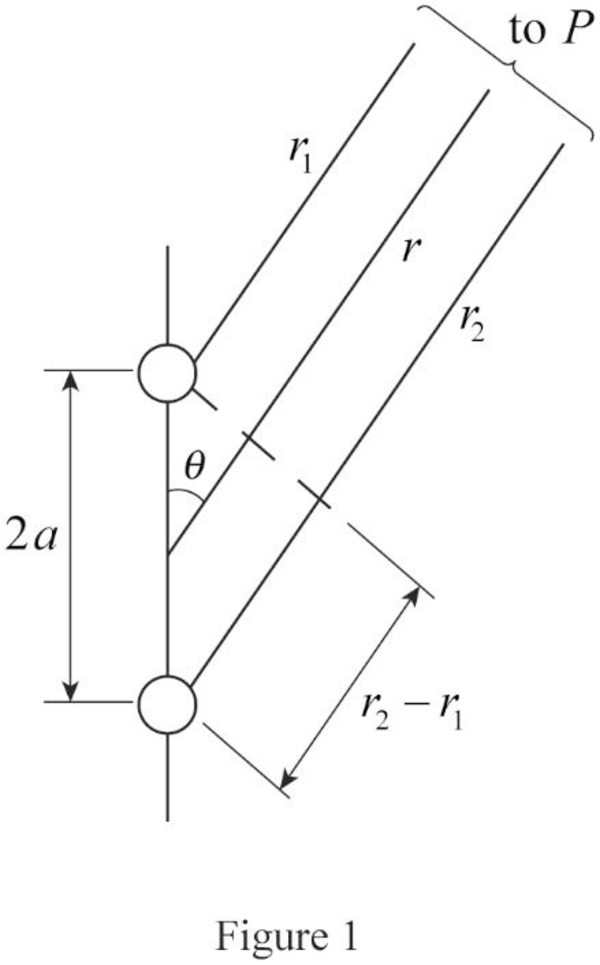
Concept explainers
(a)
The expression for the electric potential.
(a)
Answer to Problem 82P
The expression for the electric potential is
Explanation of Solution
The diagram for the system is given by figure 1.

Write the expression total potential.
Here,
Write the equation for potential difference at first point.
Here,
Write the equation for potential difference at second point.
Here,
For
Here.
The distance between the points are almost same,
Write the expression for dipole.
Conclusion:
Substitute,
Thus, the expression for the electric potential is
(b)
The radial and perpendicular component of electric field.
(b)
Answer to Problem 82P
The radial and perpendicular component of electric field is
Explanation of Solution
Write the expression for the radial component of electric field.
Here,
Write the equation for perpendicular component of electric field.
Here,
Conclusion:
Substitute,
Substitute,
Thus, the radial and perpendicular component of electric field is
(c)
The electric field at
(c)
Answer to Problem 82P
The electric field at
Explanation of Solution
Write the expression for the radial component of electric field.
Write the expression for the perpendicular component of electric field.
Conclusion:
For
Substitute,
For
Substitute,
The results are reasonable since the component of electric field is having finite value.
Thus, the electric field at
(d)
The electric field at
(d)
Answer to Problem 82P
The electric field at
Explanation of Solution
Write the expression for the radial component of electric field.
Write the expression for the perpendicular component of electric field.
Conclusion:
Substitute,
The electric field at the centre of dipole is not infinite.
The results are not reasonable since the component of electric field is having infinite value.
Thus, The electric field at
(e)
The potential in Cartesian coordinate.
(e)
Answer to Problem 82P
The potential in Cartesian coordinate is
Explanation of Solution
Write the expression for the potential.
Conclusion:
Substitute,
Thus, the potential in Cartesian coordinate is
(f)
The x and y component of electric field.
(f)
Answer to Problem 82P
The x and y component of electric field is
Explanation of Solution
Write the expression for the x component of electric field.
Here,
Write the equation for y component of electric field.
Here,
Conclusion:
Substitute,
Substitute,
Thus, the x and y component of electric field is
Want to see more full solutions like this?
Chapter 20 Solutions
Principles of Physics: A Calculus-Based Text
- How can i solve this if n1 (refractive index of gas) and n2 (refractive index of plastic) is not known. And the brewsters angle isn't knownarrow_forward2. Consider the situation described in problem 1 where light emerges horizontally from ground level. Take k = 0.0020 m' and no = 1.0001 and find at which horizontal distance, x, the ray reaches a height of y = 1.5 m.arrow_forward2-3. Consider the situation of the reflection of a pulse at the interface of two string described in the previous problem. In addition to the net disturbances being equal at the junction, the slope of the net disturbances must also be equal at the junction at all times. Given that p1 = 4.0 g/m, H2 = 9.0 g/m and Aj = 0.50 cm find 2. A, (Answer: -0.10 cm) and 3. Ay. (Answer: 0.40 cm)please I need to show all work step by step problems 2 and 3arrow_forward
- look at answer show all work step by steparrow_forwardLook at the answer and please show all work step by steparrow_forward3. As a woman, who's eyes are h = 1.5 m above the ground, looks down the road sees a tree with height H = 9.0 m. Below the tree is what appears to be a reflection of the tree. The observation of this apparent reflection gives the illusion of water on the roadway. This effect is commonly called a mirage. Use the results of questions 1 and 2 and the principle of ray reversibility to analyze the diagram below. Assume that light leaving the top of the tree bends toward the horizontal until it just grazes ground level. After that, the ray bends upward eventually reaching the woman's eyes. The woman interprets this incoming light as if it came from an image of the tree. Determine the size, H', of the image. (Answer 8.8 m) please show all work step by steparrow_forward
 Physics for Scientists and Engineers with Modern ...PhysicsISBN:9781337553292Author:Raymond A. Serway, John W. JewettPublisher:Cengage Learning
Physics for Scientists and Engineers with Modern ...PhysicsISBN:9781337553292Author:Raymond A. Serway, John W. JewettPublisher:Cengage Learning Physics for Scientists and Engineers: Foundations...PhysicsISBN:9781133939146Author:Katz, Debora M.Publisher:Cengage Learning
Physics for Scientists and Engineers: Foundations...PhysicsISBN:9781133939146Author:Katz, Debora M.Publisher:Cengage Learning Principles of Physics: A Calculus-Based TextPhysicsISBN:9781133104261Author:Raymond A. Serway, John W. JewettPublisher:Cengage Learning
Principles of Physics: A Calculus-Based TextPhysicsISBN:9781133104261Author:Raymond A. Serway, John W. JewettPublisher:Cengage Learning
 Physics for Scientists and EngineersPhysicsISBN:9781337553278Author:Raymond A. Serway, John W. JewettPublisher:Cengage Learning
Physics for Scientists and EngineersPhysicsISBN:9781337553278Author:Raymond A. Serway, John W. JewettPublisher:Cengage Learning College PhysicsPhysicsISBN:9781285737027Author:Raymond A. Serway, Chris VuillePublisher:Cengage Learning
College PhysicsPhysicsISBN:9781285737027Author:Raymond A. Serway, Chris VuillePublisher:Cengage Learning





